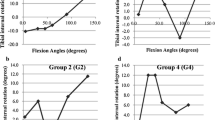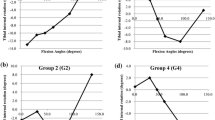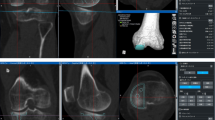Abstract
Purpose
In clinical practice, people with better femorotibial rotation in the flexed position often achieve a favourable postoperative maximum flexion angle (MFA). However, no objective data have been reported to support this clinical observation. In the present study, we aimed to investigate the correlation between the amount of intraoperative rotation and the pre- and postoperative flexion angles.
Methods
Fifty-five patients with varus osteoarthritis undergoing computer-assisted posterior-stabilized total knee arthroplasty (TKA) were enrolled. After registration, rotational stress was applied towards the knee joint, and the rotational angles were recorded by using a navigation system at maximum extension and 90° of flexion. After implantation, rotational stress was applied for a second time, and the angles were recorded once more. The MFA was measured before surgery and 1 month after surgery, and the correlation between the amount of femorotibial rotation during surgery and the MFA was statistically evaluated.
Results
Although the amount of tibial rotation at maximum extension was not correlated with the MFA, the amount of tibial rotation at 90° of flexion after registration was positively correlated with the pre- and postoperative MFA (both p < 0.005). However, no significant relationship was observed between the amount of tibial rotation after implantation and the postoperative MFA (n.s.).
Conclusion
The results showed that better femorotibial rotation at 90° of flexion is associated with a favourable postoperative MFA, suggesting that the flexibility of the surrounding soft tissues is an important factor for obtaining a better MFA, which has important clinical relevance. Hence, further evaluation of navigation-based kinematics during TKA may provide useful information on MFA.
Level of evidence
Diagnostic studies, development of diagnostic criteria in a consecutive series of patients, and a universally applied “gold” standard, Level II.



Similar content being viewed by others
References
Akagi M, Mori S, Nishimura S, Nishimura A, Asano T, Hamanishi C (2005) Variability of extraarticular tibial rotation references for total knee arthroplasty. Clin Orthop Relat Res 436:172–176
Belvedere C, Ensini A, Leardini A, Dedda V, Feliciangeli A, Cenni F, Timoncini A, Barbadoro P, Giannini S (2014) Tibio-femoral and patello-femoral joint kinematics during navigated total knee arthroplasty with patellar resurfacing. Knee Surg Sports Traumatol Arthrosc 22(8):1719–1727
Bignozzi S, Zaffagnini S, Akkawi I, Marko T, Bruni D, Neri MP, Colle F, Marcacci M (2014) Three different cruciate-sacrificing TKA designs: minor intraoperative kinematic differences and negligible clinical differences. Knee Surg Sports Traumatol Arthrosc. doi:10.1007/s00167-014-3200-5
Chinzei N, Ishida K, Matsumoto T, Kuroda Y, Kitagawa A, Kuroda R, Akisue T, Nishida K, Kurosaka M, Tsumura N (2014) Evaluation of patellofemoral joint in ADVANCE Medial-pivot total knee arthroplasty. Int Orthop 38(3):509–515
Fujimoto E, Sasashige Y, Masuda Y, Hisatome T, Eguchi A, Masuda T, Sawa M, Nagata Y (2013) Significant effect of the posterior tibial slope and medial/lateral ligament balance on knee flexion in total knee arthroplasty. Knee Surg Sports Traumatol Arthrosc 21(12):2704–2712
Ghosh KM, Blain AP, Longstaff L, Rushton S, Amis AA, Deehan DJ (2014) Can we define envelope of laxity during navigated knee arthroplasty? Knee Surg Sports Traumatol Arthrosc 22(8):1736–1743
Ishida K, Matsumoto T, Tsumura N, Kubo S, Kitagawa A, Chin T, Iguchi T, Kurosaka M, Kuroda R (2011) Mid-term outcomes of computer-assisted total knee arthroplasty. Knee Surg Sports Traumatol Arthrosc 19(7):1107–1112
Ishida K, Shibanuma N, Matsumoto T, Sasaki H, Takayama K, Matsuzaki T, Tei K, Kuroda R, Kurosaka M (2016) Navigation-based femorotibial rotation pattern correlated with flexion angle after total knee arthroplasty. Knee Surg Sports Traumatol Arthrosc 24(1):89–95
Ishida K, Shibanuma N, Matsumoto T, Sasaki H, Takayama K, Toda A, Kuroda R, Kurosaka M (2015) Factors affecting intraoperative kinematic patterns and flexion angles in navigated total knee arthroplasty. Knee Surg Sports Traumatol Arthrosc 23(6):1741–1747
Jenny JY, Clemens U, Kohler S, Kiefer H, Konermann W, Miehlke RK (2005) Consistency of implantation of a total knee arthroplasty with a non-image-based navigation system: a case-control study of 235 cases compared with 235 conventionally implanted prostheses. J Arthroplast 20(7):832–839
Kitagawa A, Ishida K, Chin T, Tsumura N, Iguchi T (2014) Partial restoration of knee kinematics in severe valgus deformity using the medial-pivot total knee arthroplasty. Knee Surg Sports Traumatol Arthrosc 22(7):1599–1606
Langlois J, Charles-Nelson A, Katsahian S, Beldame J, Lefebvre B, Bercovy M (2015) Predictors of flexion using the rotating concave–convex total knee arthroplasty: preoperative range of motion is not the only determinant. Knee Surg Sports Traumatol Arthrosc 23(6):1734–1740
Martin A, Wohlgenannt O, Prenn M, Oelsch C, von Strempel A (2007) Imageless navigation for TKA increases implantation accuracy. Clin Orthop Relat Res 460:178–184
Matsuzaki T, Matsumoto T, Kubo S, Muratsu H, Matsushita T, Kawakami Y, Ishida K, Oka S, Kuroda R, Kurosaka M (2014) Tibial internal rotation is affected by lateral laxity in cruciate-retaining total knee arthroplasty: an intraoperative kinematic study using a navigation system and offset-type tensor. Knee Surg Sports Traumatol Arthrosc 22(3):615–620
Matsuzaki T, Matsumoto T, Muratsu H, Kubo S, Matsushita T, Kawakami Y, Ishida K, Oka S, Kuroda R, Kurosaka M (2013) Kinematic factors affecting postoperative knee flexion after cruciate-retaining total knee arthroplasty. Int Orthop 37(5):803–808
Nishio Y, Onodera T, Kasahara Y, Takahashi D, Iwasaki N, Majima T (2014) Intraoperative medial pivot affects deep knee flexion angle and patient-reported outcomes after total knee arthroplasty. J Arthroplast 29(4):702–706
Roh YW, Jang J, Choi WC, Lee JK, Chun SH, Lee S, Seong SC, Lee MC (2013) Preservation of the posterior cruciate ligament is not helpful in highly conforming mobile-bearing total knee arthroplasty: a randomized controlled study. Knee Surg Sports Traumatol Arthrosc 21(12):2850–2859
Rosskopf J, Singh PK, Wolf P, Strauch M, Graichen H (2014) Influence of intentional femoral component flexion in navigated TKA on gap balance and sagittal anatomy. Knee Surg Sports Traumatol Arthrosc 22(3):687–693
Seon JK, Park JK, Shin YJ, Seo HY, Lee KB, Song EK (2011) Comparisons of kinematics and range of motion in high-flexion total knee arthroplasty: cruciate retaining vs. substituting designs. Knee Surg Sports Traumatol Arthrosc 19(12):2016–2022
Siston RA, Giori NJ, Goodman SB, Delp SL (2006) Intraoperative passive kinematics of osteoarthritic knees before and after total knee arthroplasty. J Orthop Res 24(8):1607–1614
Stiehl JB, Dennis DA, Komistek RD, Crane HS (1999) In vivo determination of condylar lift-off and screw-home in a mobile-bearing total knee arthroplasty. J Arthroplast 14(3):293–299
Tei K, Ishida K, Matsumoto T, Kubo S, Sasaki H, Shibanuma N, Akisue T, Nishida K, Kurosaka M, Kuroda R (2012) Novel image-matching software for postoperative evaluation after TKA. Orthopedics 35(12):e1711–e1715
Turcot K, Armand S, Lubbeke A, Fritschy D, Hoffmeyer P, Suva D (2013) Does knee alignment influence gait in patients with severe knee osteoarthritis? Clin Biomech 28(1):34–39
Wunschel M, Leasure JM, Dalheimer P, Kraft N, Wulker N, Muller O (2013) Differences in knee joint kinematics and forces after posterior cruciate retaining and stabilized total knee arthroplasty. Knee 20(6):416–421
Zaffagnini S, Bignozzi S, Saffarini M, Colle F, Sharma B, Kinov PS, Marcacci M, Dejour D (2014) Comparison of stability and kinematics of the natural knee versus a PS TKA with a ‘third condyle’. Knee Surg Sports Traumatol Arthrosc 22(8):1778–1785
Author information
Authors and Affiliations
Corresponding author
Rights and permissions
About this article
Cite this article
Ishida, K., Shibanuma, N., Matsumoto, T. et al. Navigation-based tibial rotation at 90° of flexion is associated with better range of motion in navigated total knee arthroplasty. Knee Surg Sports Traumatol Arthrosc 24, 2447–2452 (2016). https://doi.org/10.1007/s00167-016-4008-2
Received:
Accepted:
Published:
Issue Date:
DOI: https://doi.org/10.1007/s00167-016-4008-2




